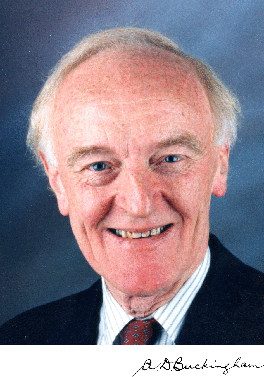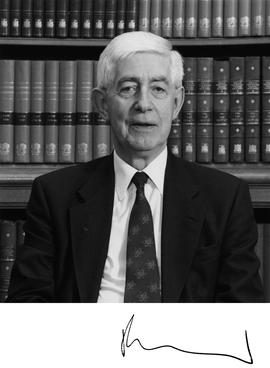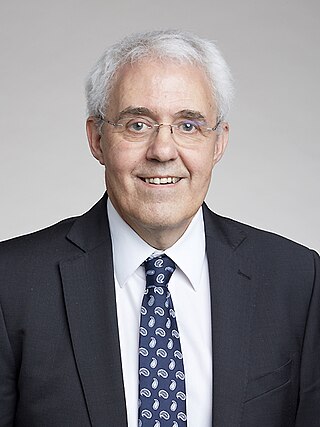Related Research Articles

The Cavendish Laboratory is the Department of Physics at the University of Cambridge, and is part of the School of Physical Sciences. The laboratory was opened in 1874 on the New Museums Site as a laboratory for experimental physics and is named after the British chemist and physicist Henry Cavendish. The laboratory has had a huge influence on research in the disciplines of physics and biology.

Sir Michael Victor Berry, is a British mathematical physicist at the University of Bristol, England.

Sir Nevill Francis Mott was a British physicist who won the Nobel Prize for Physics in 1977 for his work on the electronic structure of magnetic and disordered systems, especially amorphous semiconductors. The award was shared with Philip W. Anderson and J. H. Van Vleck. The three had conducted loosely related research. Mott and Anderson clarified the reasons why magnetic or amorphous materials can sometimes be metallic and sometimes insulating.
Post-nominal letters, also called post-nominal initials, post-nominal titles, designatory letters or simply post-nominals, are letters placed after a person's name to indicate that the individual holds a position, an academic degree, accreditation, an office, a military decoration, or honour, or is a member of a religious institute or fraternity. An individual may use several different sets of post-nominal letters, but in some contexts it may be customary to limit the number of sets to one or just a few. The order in which post-nominals are listed after a name is based on rules of precedence and what is appropriate for a given situation. Post-nominal letters are one of the main types of name suffix. In contrast, pre-nominal letters precede the name rather than following it, such as addressing a physician or professor as "Dr. Smith".
Ian Philip Grant, DPhil; FRS; CMath; FIMA, FRAS, FInstP is a British mathematical physicist. He is Emeritus Professor of Mathematical Physics at the University of Oxford and was elected a fellow of the Royal Society in 1992. He is a pioneer in the field of computational physics and is internationally recognised as the principal author of GRASP, the General Relativistic Atomic Structure Program.

Amyand David Buckingham born in Pymble, Sydney, New South Wales, Australia was a chemist, with primary expertise in chemical physics.

Sir Keith Burnett, CBE, FRS FLSW FINSTP is a British physicist and President Elect of the Institute of Physics. He is Chair of the Nuffield Foundation — an independent charitable trust with a mission to advance educational opportunity and social well-being, founding Chair of the Academic Council the Schmidt Science Fellows, and a member of the Board of international education providers Study Group.

The Department of Materials Science and Metallurgy (DMSM) is a large research and teaching division of the University of Cambridge. Since 2013 it has been located in West Cambridge, having previously occupied several buildings on the New Museums Site in the centre of Cambridge.

Peter Neil Temple Wells CBE DSc FMedSci FREng FIET FInstP FLSW FRS was a British medical physicist who played a major role in the application of ultrasound technology in medicine.

David Ian Olive ; 16 April 1937 – 7 November 2012) was a British theoretical physicist. Olive made fundamental contributions to string theory and duality theory, he is particularly known for his work on the GSO projection and Montonen–Olive duality.
Michael John Whelan HonFRMS FRS FInstP is a British scientist.
Colin Edward Webb is a British physicist and former professor at the University of Oxford, specialising in lasers.

Sir Colin John Humphreys, is a British physicist. He is the Professor of Materials Science at Queen Mary University of London.
The Nevill Mott Medal and Prize is an award presented in selected years by the Institute of Physics in the United Kingdom, for distinguished research in condensed matter or materials physics. It was first established in 1997 thanks to a donation from Sir Nevill Mott's family. Sir Nevill Mott was one of the outstanding British condensed matter theorists and won a Nobel Prize in Physics in 1977. He died in 1996. The award consists of a silver medal and a prize of £1000.

Alan Carrington CBE, FRS was a British chemist and one of the leading spectroscopists in Britain in the late twentieth century.
Sir Roger James Elliott was a British theoretical physicist specialising in the magnetic, semiconductor, and optical properties of condensed matter.
Sir Charles Richard Arthur Catlow FLSW is a British chemist and professor at University College London and Cardiff University. Previously, he was Director of the Davy-Faraday Research Laboratory (1998–2007), and Wolfson Professor of Natural Philosophy at the Royal Institution. Since 2016, he has served as the foreign secretary of the Royal Society., and since 2021 as President of the InterAcademy Partnership (IAP).

Anthony Raymond Bell is a British physicist. He is a professor of physics at the University of Oxford and the Rutherford Appleton Laboratory. He is a senior research fellow at Somerville College, Oxford.
Sir Robert Hughes Williams,, commonly known as Robin Williams, is a Welsh physicist and academic, specialising in solid state physics and semiconductors. He was Vice-Chancellor of University of Wales, Swansea from 1994 to 2003. He had taught at the New University of Ulster and University of Wales, College of Cardiff, before joining Swansea.
Amalia Patanè is an Italian physicist who is Professor of Physics at the University of Nottingham and UK Director of the European Magnetic Field Laboratory.
References
- 1 2 "Prof Laurence Eaves, CBE, FRS Authorised Biography – Debrett's People of Today, Prof Laurence Eaves, CBE, FRS Profile". www.debretts.com. Archived from the original on 19 June 2013.
- ↑ "Staff Listing - the University of Nottingham".
- ↑ Wales, The Learned Society of. "Laurence Eaves". The Learned Society of Wales. Retrieved 30 August 2023.